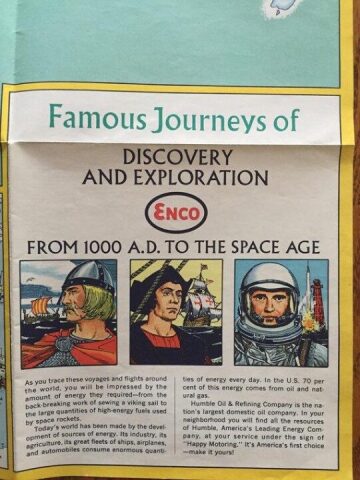
A brochure by the Humble Oil and Refining Company from 1963 (6 years before the moon landing) talks about and maps out how human exploration through voyages, odysseys, and flights has been fueled by the oil industry. Today, the oil and gas industry is at a very different place, and not a good one. But not all hope is lost, and that’s what I want to talk about: where we came from, where we are today, and where we are headed.

30 May 2020 will be remembered and celebrated as the day that Elon Musk’s vision came to fruition as his reusable rocket launched two astronauts to the International Space Station. The successful development of reusable rockets changed the space industry forever. SpaceX started on 6 May 2002; it took 18 years of excruciatingly hard work. 18 years is relatively short in the lifespan of an industry. For context, note that Boeing started in 1916 and NASA in 1958. The incumbents were working on continuous developments, whereas what the industry needed was a shock. That’s what SpaceX delivered by starting from a white-canvas and going back to the first principles. Reusable rockets changed it all—from putting humans in orbit to the next milestones for deep-space exploration to Mars and making humanity a multiplanetary species.
The oil and gas industry was created by fierce entrepreneurs, wildcatters, and visionaries. But, in the last 50 years, it has lost its way—and definitely it’s mojo. We stopped innovating; we became complacent thinking that we are too big to fail. And we ignored the side effects of our product in an increasingly complex world. How did we get here? How does an industry that powers the world, provides energy for all other industries, (which, by the way, is why we can live the comfortable lives that we live) gotten to such a pitiful place as to be compared with tobacco, a useless product? That’s what I mean when I say we have lost our way, and it happened during the last 50 years.
We got here by a series of bad marketing strategies and not innovating enough. We didn’t explain the benefits of what we do, and we did an absolutely terrible job of addressing global warming and climate-change concerns. Before that (1900–1970), the benefits of fossil fuels were tangible for the public. In the last 50 years, humanity has made so much industrial progress and created a multilayer complex supply chain to make it happen, and, because of that, the public doesn’t have a tangible sense of why oil and gas are needed, how electricity is made, or what the feedstock is to make plastics. It was our job to explain that, and we failed. That, coupled with ignoring our emissions and lack of technology to address it proactively, has led to where we are, and that should not be a surprise.
The oil and gas industry desperately needs a SpaceX type of innovation, a paradigm shift. Creating this future is the mission for Cemvita Factory. Here are four pillars upon which we think the reinvention of the oil and gas industry should be based:
Oil and Gas as Feedstock To Make Chemicals Not Fuels
All cars will be electric (and autonomous) by 2050, if not sooner. Eventually, planes and heavy machinery will be as well. Fuels create emissions, and, when other energy sources are available, it should be replaced. On that note, I also propose that we finally retire the phrase “fossil fuels” and use “natural subsurface feedstocks” instead. Subsurface oil and gas are products of nature. Soon, they can be manufactured with synthetic biology, and, therefore, the word “fossil” won’t apply. If the intention is to use them as chemical feedstocks, then the word “fuels” won’t apply. To the extent that natural subsurface feedstocks are used to produce fuel for heavy industrial operations, that fuel should be produced in a carbon-neutral or -negative manner.
Reuse of the Subsurface Pore Space
As mentioned, at the core of SpaceX’s mission was to make rockets reusable, thereby drastically reducing the cost of space travel.
If one can figure out how to effectively reuse rockets just like airplanes, the cost of access to space will be reduced by as much as a factor of a hundred. A fully reusable vehicle has never been done before. That really is the fundamental breakthrough needed to revolutionize access to space.
In the oil and gas industry, we spend billions of dollars in upstream exploration, drilling, and production, and, then, once the reservoir is depleted beyond enhanced oil recovery, what do we do? We spend even more money to plug and abandon the pore space. This is a huge waste, similar to burning a rocket after it has flown once. With the advent of carbon capture, utilization, and storage (CCUS), coupled with advancements in synthetic biology, we can use this depleted pore space indefinitely as a subsurface facility to enhance nature’s ability to replenish the natural subsurface feedstocks.
Integration of Upstream and Downstream
Currently, a huge amount of inefficiencies exists because oil and gas upstream and downstream are disconnected. Even at integrated oil and gas companies, upstream and downstream often operate independently. This strategy also has proved punishing to the upstream sector, leading to it being viewed as the main greenhouse-gas emitters. Oil and gas companies of the future will have an integrated work flow from natural subsurface feedstocks to the end result of chemicals not fuels. The rise of CCUS further strengthens this point by allowing for the creation of closed carbon loops—from CO2 (either captured from the air or from heavy-industry flue gas) to natural subsurface feedstocks to end chemicals—which helps make those end chemicals carbon neutral or even carbon negative.
Use of CO2 as Feedstock
The oil and gas industry should accept major responsibility for the rising levels of atmospheric CO2. That doesn’t make natural subsurface feedstocks the devil; they are just a compact source of energy that is easy to store and use. They are a source of energy just like any other. It does mean, however, that we should address this issue by application of technology—CCUS, most importantly the utilization aspect. CO2 is a stable molecule and not an ideal feedstock. Rockets flown into space also don’t like to be reused, but that’s where human ingenuity comes in. With recent advancements in synthetic biology and artificial photosynthesis, using CO2 as feedstock is becoming feasible and is a few years away from becoming fully economically viable. Nonetheless, the oil and gas industry owes it to the citizens of the Earth to solve the CO2 issue and return the atmospheric level back to 350 ppm (from the current 416 ppm). This is possible. As an example, at Cemvita Factory, we have created a nature-inspired pathway from CO2 to bioethylene that can use 50 million tons of CO2 per year by 2030, and that can ramp up to almost 1 billion tons of CO2 per year by 2050. Coupled with other CO2 utilization applications, the reinvented oil and gas industry can use several gigatons of CO2 per year by 2050. This is really important for staying within our carbon budget (1 trillion tons of CO2) by 2050 to limit the global temperature rise to 2°C above preindustrial levels. The oil and gas industry already has the infrastructure and what it takes to take the lead on CCUS, and it absolutely should.
Where Do We Go From Here?
Alan Kay said, “The best way to predict the future is to invent it.” I don’t think he was trying to be inspirational. This is just true. So, it’s up to us to envision a thriving future for the oil and gas industry for 2050 and beyond, which may look nothing like it is today, and put in the work to make it happen.
We can awaken the explorer within each of us in the oil and gas industry and invent our way into the future that we want and that the world needs.

